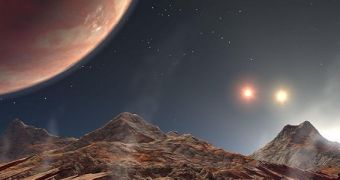According to the conclusions of a new scientific investigation conducted by experts at the McMaster University in Ontario, Canada, it would appear that many extrasolar moons orbiting exoplanets are scorched and left barren well before they have the chance to develop life.
Over the past few years, several studies have shown that exomoons, especially those around gas giants such as Jupiter, have a higher chance of supporting alien life than exoplanets. The new study comes to show that this may not be the case, since many exomoons lose their water when they are very young.
René Heller, a postdoctoral fellow in astronomy at McMaster, worked with scientists at the NASA Virtual Planetary Laboratory, and expert Rory Barnes from the University of Washington, to determine that freshly-formed exoplanets would irradiate their new moons with vast amounts of radiations.
The parent star would also contribute with more radiation, potentially causing exomoons to experience catastrophic water loss, to the point where they resemble just barren wastelands. Life would have a very hard time developing here, the team concludes, quoted by Astrobiology Magazine.

 14 DAY TRIAL //
14 DAY TRIAL //